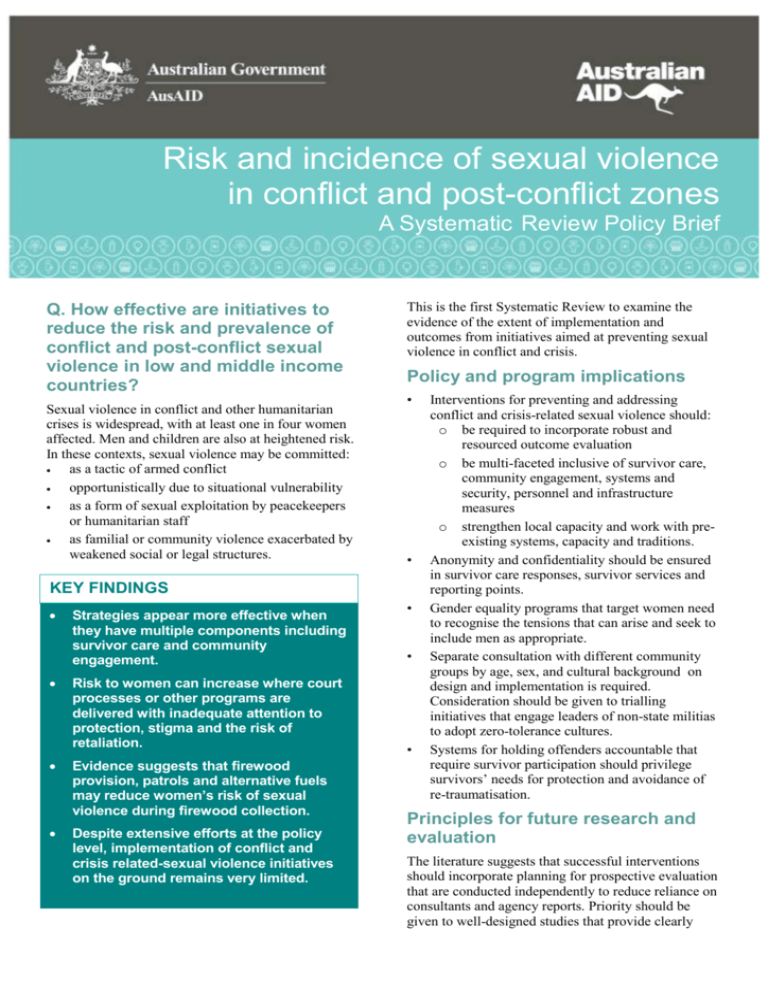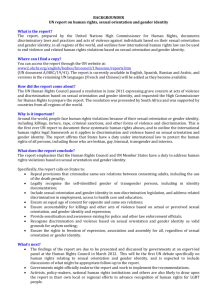
Risk and incidence of sexual violence
in conflict and post-conflict zones
A Systematic Review Policy Brief
Q. How effective are initiatives to
reduce the risk and prevalence of
conflict and post-conflict sexual
violence in low and middle income
countries?
Sexual violence in conflict and other humanitarian
crises is widespread, with at least one in four women
affected. Men and children are also at heightened risk.
In these contexts, sexual violence may be committed:
as a tactic of armed conflict
opportunistically due to situational vulnerability
as a form of sexual exploitation by peacekeepers
or humanitarian staff
as familial or community violence exacerbated by
weakened social or legal structures.
This is the first Systematic Review to examine the
evidence of the extent of implementation and
outcomes from initiatives aimed at preventing sexual
violence in conflict and crisis.
Policy and program implications
•
•
KEY FINDINGS
Strategies appear more effective when
they have multiple components including
survivor care and community
engagement.
Risk to women can increase where court
processes or other programs are
delivered with inadequate attention to
protection, stigma and the risk of
retaliation.
Evidence suggests that firewood
provision, patrols and alternative fuels
may reduce women’s risk of sexual
violence during firewood collection.
Despite extensive efforts at the policy
level, implementation of conflict and
crisis related-sexual violence initiatives
on the ground remains very limited.
•
•
•
Interventions for preventing and addressing
conflict and crisis-related sexual violence should:
o be required to incorporate robust and
resourced outcome evaluation
o be multi-faceted inclusive of survivor care,
community engagement, systems and
security, personnel and infrastructure
measures
o strengthen local capacity and work with preexisting systems, capacity and traditions.
Anonymity and confidentiality should be ensured
in survivor care responses, survivor services and
reporting points.
Gender equality programs that target women need
to recognise the tensions that can arise and seek to
include men as appropriate.
Separate consultation with different community
groups by age, sex, and cultural background on
design and implementation is required.
Consideration should be given to trialling
initiatives that engage leaders of non-state militias
to adopt zero-tolerance cultures.
Systems for holding offenders accountable that
require survivor participation should privilege
survivors’ needs for protection and avoidance of
re-traumatisation.
Principles for future research and
evaluation
The literature suggests that successful interventions
should incorporate planning for prospective evaluation
that are conducted independently to reduce reliance on
consultants and agency reports. Priority should be
given to well-designed studies that provide clearly
METHODOLOGY
defined interventions and outcomes and consider
contextual factors. Research and evaluation initiatives
should also include representation from practitioners
and community groups to reflect the concerns of those
on the ground.
Systematic reviews identify, synthesise and assess
all available evidence around a specific research
question.
Scope: Studies published from 1990 to
September 2011 containing primary empirical
data describing implementation or impact of
interventions to reduce, risk, incidence or harm
from sexual violence occurring in conflict, postconflict or other humanitarian crisis in low and
middle income countries .
Searching: 2656 studies identified from 23 major
databases and 26 relevant websites
In-depth review: Analysis was conducted on 40
studies around reported outcomes, contextual
factors and underlying program mechanisms.
Evidence for reducing risk,
incidence and harm from sexual
violence
Due to the limited number and nature of evaluations to
date, the Review concluded that there is presently
insufficient evidence to confidently determine overall
intervention effectiveness. However, some emerging
insights relating to effectiveness were identified:
effectiveness of initiatives to prevent sexual
exploitation and abuse by peacekeepers in settings
where enforcement of policies was visible to the
community
the harm-reduction impact of medical care and
follow-up trauma counselling for victims
firewood provision, patrols, and alternative fuels
have reduced the risk to women during firewood
collection.
The Review also identified some responses that
inadvertently increased risk for survivors, particularly
legal interventions where witnesses were unprotected
and exposed to stigma and retaliation.
Extent and nature of evidence
Forty studies were subjected to detailed analysis.
Although much of the broader literature focuses on
sexual violence committed by armed groups, the
majority of interventions identified address sexual
violence committed opportunistically or within the
family or community. Studies were undertaken in 26
countries but predominantly on the African continent
and the former Yugoslavia. No studies from the Pacific
were identified.
Twenty studies reported only on the implementation of
interventions, while the other 20 also reported
outcomes. Most described interventions for sexual
violence in post-conflict settings, whereas few
addressed prevention or conflict contexts. Only one
study specifically addressed a natural disaster setting.
The literature identifies seven different strategies to
reduce sexual violence:
survivor care interventions
livelihood initiatives (to reduce women’s
vulnerability through financial independence)
community mobilisation
personnel initiatives (e.g. gender specific
recruitment)
systems and security, predominantly firewood
patrols or fuel alternatives
interventions using a combination of these
strategies
legal interventions.
Most interventions were focused on women. Two
disarmament and demobilisation programs were
specifically established for young people, but neither
reduced risk nor incidence. No studies focused on men
specifically as victims. Most studies were assessed as
low or medium-low weight of evidence using a quality
of evidence tool. This reflects the difficulty of
conducting research in crisis settings.
It is clear that despite extensive efforts at the policy
level to develop guidelines and training courses
implementation of initiatives on the ground remains
limited. This was a unifying finding of the three
studies with the highest weight of evidence.
Further reading
The full Systematic Review will be available from
April 2013 on the AusAID research webpages:
www.ausaid.gov.au/research
Spangaro J, Zwi A, Adogu C, Ranmuthugala G,
Powell-Davies G, & Steinacker L (2013) “Evidence
for the impact of initiatives to reduce risk and
incidence of sexual violence in conflict and crisis”
Systematic Review Technical Report, EPPI-Centre,
University of London. http://eppi.ioe.ac.uk/cms
Marsh M, Purdin S, Navani S (2006) “Addressing
sexual violence in humanitarian emergencies” Global
Public Health 1: 133 - 146.
Rowley E, García-Moreno C, & Dartnall E (2012)
“Research agenda for sexual violence in humanitarian,
conflict and post-conflict settings” WHO, Geneva.
Research team: Jo Spangaro, Anthony Zwi, Chinelo Adogu, Geetha Ranmuthugala, Gawaine Powell-Davies, Léa Steinacker,
University of New South Wales, Sydney, Australia.
Advisory Group: Claudia Garcia-Moreno, Anna Whelan, Sarah Chynoweth, Barbara O'Dwyer, Chen Reis, Louise Chappell,
Sophie Read-Hamilton, Sarah W. Spencer, Kavitha Suthanthiraraj. Gill Westhorp advised on Review approach.
Coordinating Group: This review is registered with the EPPI-Centre, Institute of Education, University College London
This document is an output from research funded by AusAID. The views and opinions expressed in this document are
those of the authors and do not necessarily reflect the views of AusAID or the Australian Government.
http://www.ausaid.gov.au/research









